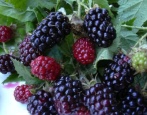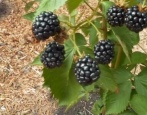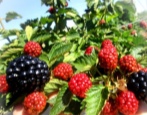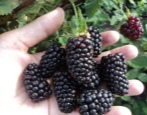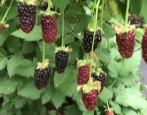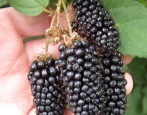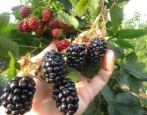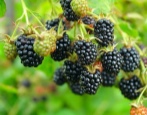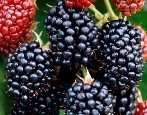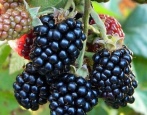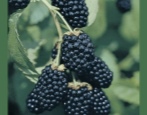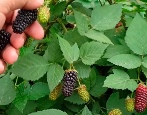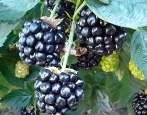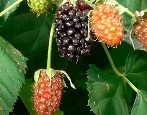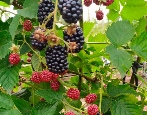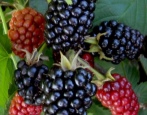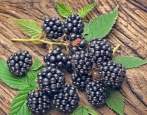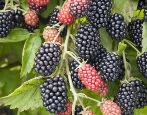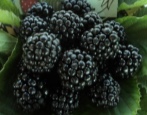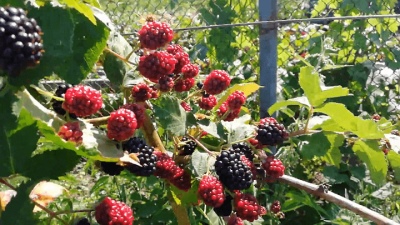
- Authors: USA
- Taste: sweet
- Scent : pronounced
- The presence of thorns: No
- Repairability: Yes
- Berry weight, g: 15-25
- Berry size: large
- Berry color: black
- Fruiting period: from July, within six weeks
- Yield: 10 kg per bush
Until recently, blackberries were a rare guest on the personal plot, because they are too whimsical, and harvesting because of the thorns on the branches is not very convenient and pleasant. Everything has changed with the advent of thornless blackberry varieties, resistant to any weather conditions and unpretentious in care. One of these is the American variety Chief Joseph.
Breeding history of the variety
Blackberry Leader Joseph is a promising variety, massively grown on an industrial scale. For its productivity and unpretentiousness, gardeners and summer residents love it very much. This species was bred a very long time ago by American breeders, and was named after the famous leader. As a result of crossing which blackberry varieties, Chief Joseph appeared, is still unknown.
Description of the variety
Blackberries of this variety are rightfully called universal, since they are consumed fresh, and canned, and frozen. Due to their dense structure, the berries tolerate transportation well, therefore commercial cultivation is a priority.
Ripening terms
Blackberry Chief Joseph is characterized by an extended period of ripening and fruiting - from 6 to 8 weeks (from late July to September). Depending on climatic conditions, the ripening and harvesting period can be shifted.
Yield
The yield is very high, but it should be borne in mind that the first full-fledged crop can be harvested in the third growing season. On average, up to 6-10 kg of blackberries can be harvested from each bush, but in very productive periods, up to 11-13 kg of berries are harvested. Due to the fact that the variety is remontant, the crop can be harvested twice a season.
Berries and their taste
The berries are very large - the weight of each reaches 15-25 g. The fruits have a rounded-elongated shape, black color with a glossy sheen. The taste of blackberries is quite pronounced: there is both a cloying sweetness and a slight sourness. The aroma of blackberries is very rich, so jelly, compotes and drinks are incredibly tasty.
Growing features
The blackberry variety Leader Joseph is especially unpretentious in care, so even an inexperienced gardener can cope with its cultivation and cultivation.
This variety is able to adapt to almost all climatic conditions, that is, it is resistant to droughts, frosts, and heat. In an arid climate, an irrigation system is used, abundant watering, and in severe frosts, a warming procedure is used. Well-drained and fertile soils are most favorable for cultivation.
Site selection and soil preparation
Having chosen a place (it is desirable that it be a zone of a small hill, and not a lowland), it should be prepared: dig it up, clean it of vegetation remnants and level it. The site should be illuminated by sunlight or in partial shade. The main thing is that there are no drafts and strong winds, therefore, places are planted with blackberries near the fence, which performs a protective function.
Pruning
In early spring, branches that have reached a length of 2-2.5 m are shortened by 15-20 cm. Lateral branches, the length of which is 1 m or more, should also be slightly shortened. In the fall, branches that have finished fruiting are cut off at the root.A good bush is 7-10 branches.
Watering and feeding
Since the variety is quite drought-resistant, frequent watering is not recommended, only in case of extreme heat. Water protects the root system from overheating. As for feeding, it must be done in the spring before the flowering of the bushes. And also before the formation of the first fruits. For this, complex nitrogen-mineral fertilizers are used.
Frost resistance and preparation for winter
At the end of the fruiting season, the bushes should be prepared for wintering. The branches should be removed from the supporting structures (trellises) and carefully tied, laid on the ground, and then covered with insulating material (agrofibre).
Diseases and pests
The plant has good immunity, therefore, it does not have frequent diseases. The only thing that attacks the bushes are spider mites, which are removed by treating the plant with special preparations. Sometimes rust appears, eating the leaves.
Reproduction
The variety is propagated by digging the upper branches into the ground. After rooting, there is a neat separation from the main bush.
Review overview
Given the many reviews of farmers and amateur gardeners, it can be argued that the Blackberry Chief Joseph is a fruitful crop that does not require much attention and experience for cultivation and cultivation. Due to its bright taste and juiciness, housewives love to make preparations for the winter from it in the form of jams, compotes, and preserves.
But there are also negative reviews. Some gardeners are unhappy with the fact that in the first year the harvest is weak, and the berries can be small and bland, but do not forget that in the future this is compensated by an abundant collection of berries, which will be juicy, huge and sweet.
